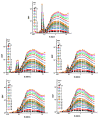A Closer Look on Nuclear Radiation Shielding Properties of Eu3+ Doped Heavy Metal Oxide Glasses: Impact of Al2O3/PbO Substitution
- PMID: 34576558
- PMCID: PMC8466938
- DOI: 10.3390/ma14185334
A Closer Look on Nuclear Radiation Shielding Properties of Eu3+ Doped Heavy Metal Oxide Glasses: Impact of Al2O3/PbO Substitution
Abstract
In this study, a group of heavy metal oxide glasses with a nominal composition of 55B2O3 + 19.5TeO2 + 10K2O + (15-x) PbO + xAl2O3 + 0.5Eu2O3 (where x = 0, 2.5, 5, 7.5, 10, 12.5, and 15 in wt.%) were investigated in terms of their nuclear radiation shielding properties. These glasses containing lanthanide-doped heavy metal oxide were envisioned to yield valuable results in respect to radiation shielding, and thus a detailed investigation was carried out; the obtained results were compared with traditional and new generation shields. Advanced simulation and theoretical methods have been utilized in a wide range of energy regions. Our results showed that the AL0.0 sample with the highest PbO contribution had superior shielding properties in the entire energy range. The effective removal of cross-sections for fast neutrons (ΣR) was also examined. The results indicated that AL5.0 had the greatest value. While increasing the concentration of Al2O3 in samples had a negative effect on the radiation shielding characteristics, it can be concluded that using PbO in the Eu3+ doped heavy metal oxide glasses could be a useful tool to keep gamma-ray shielding properties at a maximum level.
Keywords: Al2O3; Eu2O3; Phy-X/PSD; heavy metal oxide glasses; radiation shielding.
Conflict of interest statement
The authors declare no conflict of interest.
Figures
















References
-
- Tavares J.B., Sacadura-Leite E., Matoso T., Neto L.L., Biscoito L., Campos J., Sousa-Uva A. The importance of protection glasses during neuroangiographies: A study on radiation exposure at the lens of the primary operator. Interv. Neuroradiol. 2016;22:368–371. doi: 10.1177/1591019916628322. - DOI - PMC - PubMed
-
- Naseer K.A., Arunkumar S., Marimuthu K. The impact of Er3+ ions on the spectroscopic scrutiny of Bismuth bari-umtelluroborate glasses for display devices and 1.53 μm amplification. J. Non-Cryst. Solids. 2019;520:119463. doi: 10.1016/j.jnoncrysol.2019.119463. - DOI
-
- Divina R., Suthanthirakumar P., Naseer K.A., Marimuthu K. Luminescence studies on Eu3+ ions doped telluroborate glasses for photonic applications; Proceedings of the AIP Conference Proceedings; Malang, Indonesia. 26–28 August 2019; - DOI
-
- Naseer K.A., Marimuthu K., Al-Buriahi M.S., Alalawi A., Tekin H.O. Influence of Bi2O3 concentration on bari-um-telluro-borate glasses: Physical, structural and radiation-shielding properties. Ceram. Int. 2021;47:329–340. doi: 10.1016/j.ceramint.2020.08.138. - DOI
LinkOut - more resources
Full Text Sources

